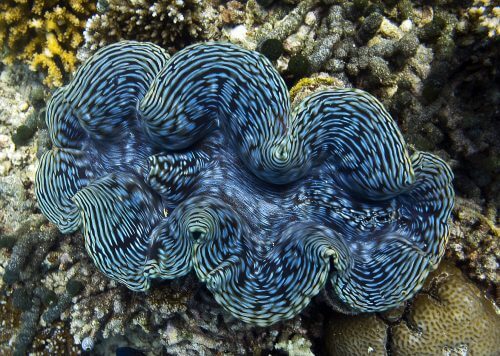American scientists have discovered an efficient method of producing biofuel from algae inspired by the blue iridescent tissue of giant oysters

By: Yossi Cohen
Many scientists are investigating the mechanism of producing biofuel from algae, because of the great potential inherent in it for a continuous supply of green and environmentally friendly fuel. University of Pennsylvania scientists have discovered an efficient method of producing biofuel from algae inspired by the iridescent blue tissue of giant clams, which is visible when they open.
These huge oysters from the TRIDACNIDAE family, reach a length of about 1.2 meters and a weight of over 200 kg (!). They are common on the coral reefs of Australia and on islands in the tropical western Pacific. These giant oysters are located in shallow water on the reef, and when they open they are exposed to strong solar radiation that can destroy them. Also in this area on the reef there is not enough food to feed this huge organism. The reason for the survival of these giant oysters in this hostile area is the presence (within the oyster tissue) of single-celled SYMBIODINIUM algae, which have a photo-symbiotic relationship with the oysters. The algae protect the oysters from strong solar radiation by absorbing the light in the photosynthesis process, and the host oysters (HOST) benefit from the photosynthesis products of the algae that are used as nutrients for them.
The bright blue color of the mantle that adorns the lips of the oyster is also a result of the symbiosis with algae. The blue mantle consists of cells containing the amino acid guanine (IRIDOCYTES). These cells are made up of microscopic burrows about 2 cm long where the algae develops (about 300 algae cells in each burrow) and absorbs the yellow and green light. The rest of the light spectrum that is not absorbed by the algae is reflected and gives the oyster shell its elegant blue color.
To date, the SCALE UP of laboratory processes to produce biofuel from algae has failed mainly because not enough light penetrated all the photosynthetic cells of the algae. Researchers ALISON SWEENEY and SHU YANG from the University of Pennsylvania solved this problem by producing a substance that mimics the action of IRIDOCYTES cells. They synthesized nanoparticles and mixed them in an oil-in-water emulsion. While mixing the mixture, the nanoparticles formed microbeads (MICROBEADS) that mimic the IRIDOCYTES in their structure. Researcher YANG claims that unlike the complicated methods developed to date for the production of nanoparticles, the method of producing IRIDOCYTES in an effective emulsion is cheap and simple and allows control of the desired size of the nanoparticles.
The next step of the research will be to grow algae in gel cavities and use them to turn light energy into biofuel, with the same efficiency as the giant clam. If this technology is developed, it will be possible to use it not only for the efficient production of biofuel, but also for heating and cooling buildings using solar panels.
See more on the subject on the science website:

One response
Peace,
I would like to inquire about a lecture on biomimicry.
Thanks